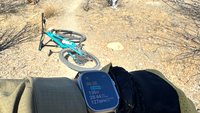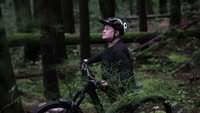my leg strength is lacking of late. ever since coming back from injury i've struggled to regain fitness and now my back and knees are getting sore as i ramp it up. i'm feeling like greater leg power is called for. my lanky body does not love squats or deadlifts but it seems there is no real substitution- power requires hard work. and for me that means DOMS. sigh… so a question for you squatters; thighs parallel to floor or all the way down, butt to heels. lots of hard opinions on the matter on the guru websites. what say you.
squatting
parallel
Freedom of contract. We sell them guns that kill them; they sell us drugs that kill us.
DOMS is at its worst when embarking on "new" movements. Keep on keeping on and it will go away.
As someone who likes falling down mountains ahead of strength training, I'm often sidelined. If I'm off for as little as a month my first week back is hell. By my third week I'm back in the groove and awaiting my next sports injury.
The second part of your question… Since you are strength training for life and not for profit, I'd ask myself if I'd benefit from training past some arbitrary line used to judge power lifting meets, let alone half of that line which the gym rats at every local gym strains to cross.
Start light when going deep. When you first start going deep, you're probably only going to parallel. At some point your joints will say no more just because they're getting in the way, at which point you're past parallel. Congrats, very few ever make it there.
I reiterate. Go light.
I have to agree with ReductiMat - for the hobbyist's body I think that going all the way down is best for your body, although it requires a pretty open and flexible hip, so that your spine can be held in a neutral position (i.e. not rounding or bending on the way down). The adaptation stimulus is better, at least for me.
I usually do a few sets without any weight at all even before I start with the warming-up sets, so that I focus on proper form adn technique. There are some videos out there that show how to actively push out the knees with the elbows when doing bw suats.
There even is an interesting article by Marty Gallagher that deals with load in squatting and what is best for non-power or O-lifters. It is pretty new, can not recall the adress though.
If you do not have access to a very good coach, I highly recommend Rippetoe's Starting Strength book - he describes the Squat along with DLs, Presses, and the like in great detail along with some useful bits and pieces, and informative pictures, really recommended.
"You don't learn from experience. You learn from reflecting on the experience."
- Kristen Ulmer
And yes, hgo light and slowly adapt your whole body to more weight - strength and power is more than moving more weight. Depending on your age and medical record, your joints, tendons and ligaments will be happy about not moving maximum weight. These take longer to adapt than muscles.
You have the rest of your life, so do not rush into things. I did the mistake last year, and could hardly ride my bike, let alone commute at a comfy pace. Now I ditched heavy squatting, do some swings and goblet squats and light barbell squats to focus on quality of movement - and I enjoy commuting and riding with my son.
"You don't learn from experience. You learn from reflecting on the experience."
- Kristen Ulmer
An alternative approach when starting out.
Do squats no weight to generate proper form.
Then, get a wobble board that goes side to side (as apposed to the round ones) and do body squats on that. It will help develop multiple small muscles and help your lower body move more dynamically.
Doesn't matter if the board is always even, but the squatting with your ankles tendons and knees in variable positions adds some dynamism. The effort of balancing is important.
Add weight. Use a 10/25/35 lb plate. 10 reps out front. 10 in left hand and 10 in right hand.
If you have a half buso this is also a great tool and adds some additional dynamism.
Been using this during the ski season (along with 2 other lower body exercises) for years and it is very effective for pre riding season training. I have a bad back and this gives me no issues.
It will add less bulk and develops you lower body in a less static manner.
Another alternative for starting out and riding season leg strength is simple squat jumps: 6x10 to start and up to 6x50. Helps develop some endurance and explosiveness while developing and maintaining strength.
squat every day. not necessarily hard, but do a squat variation every day even if just for bodyweight.
as for depth, ATG is a natural range of movement, whether you can handle that under a heavy load is another question - we're not all built the same. but like RM said, they key to depth is testing it going light. ideally you should be able to do a body weight ATG with good form before you start adding weight. personally i like overhead squats for training depth as you're pretty much forced to maintain good form.
We don't know what our limits are, so to start something with the idea of being limited actually ends up limiting us.
Ellen Langer
good stuff, thanks guys. no heavy weight for me, i'm 47 and gone this route before. heavy not even really possible frankly. good reminders to do body weight and goblet squats. will try the balance board as well. i like to sit in a deep squat as a daily stretch to loosen the low back and groin so i'm fairly limber. different when you add weight though!
Just a note on proper form: try doing squats with no weight, with your feet touching, or as close as possible, to a wall. Go as low as you can without letting your knees touch the wall. This is how low you can safely squat with weight. All your weight should be on your heels.
The best advice in this thread so far is for you to pick up a copy of Starting Strength (3rd Edition) and read the squatting section which explains (in depth) why you need to squat BELOW parallel but not Ass to Grass. If you do not want to spend the $29.95 on this strength training gold standard, take a peek at some of these articles by the same author. You may want to pay specific attention to #4 if you are concerned about exacerbating knee problems.
If you truly want to get stronger, you need to figure out a program (e.g. 3 sets of 5, 3x per week) and you will also need to incrementally LOAD your squats (e.g. add 5 or 10 pounds each session) in order to make progress in your strength (read: not more volume, but more weight). Your initial squatting sessions should not be so heavy/difficult that you have severe DOMS and you should be okay to train again after a day or two of rest. Giving yourself DOMS is counter-productive.
Wobble boards are a distraction from doing what truly matters to you; which is to get stronger. Being able to do back squats and manoeuvring a barbell on your back will do much more for your balance and 'little muscles' then vacuously waiving light weights around on an unstable surface. Think about it this way, will learning to squat 300# on a stable surface be more beneficial then only being able to only squat 150# on an unstable surface?
and for god sakes don't weight your heels or your fore foot in a squat. Weight should be evenly distributed across your foot and an iota of thought to the physics of the matter should explain the 'why' of that.
Goin' Down?
Go run up a hill
Rinse,repeat,leave the gym to the arnolds
Pastor of Muppets
Go run up a hill
Rinse,repeat,leave the gym to the arnolds
That's the cardio component… Not strength.
I like front squats right now.
As for squatting, start light and go as low as you can. The DOMS goes away eventually, but I find BCAA and glutamine supplementation helps too.
The best advice in this thread so far is for you to pick up a copy of Starting Strength (3rd Edition) and read the squatting section which explains (in depth) why you need to squat BELOW parallel but not Ass to Grass. If you do not want to spend the $29.95 on this strength training gold standard, take a peek at some of these articles by the same author. You may want to pay specific attention to #4 if you are concerned about exacerbating knee problems.
If you truly want to get stronger, you need to figure out a program (e.g. 3 sets of 5, 3x per week) and you will also need to incrementally LOAD your squats (e.g. add 5 or 10 pounds each session) in order to make progress in your strength (read: not more volume, but more weight). Your initial squatting sessions should not be so heavy/difficult that you have severe DOMS and you should be okay to train again after a day or two of rest. Giving yourself DOMS is counter-productive.
Wobble boards are a distraction from doing what truly matters to you; which is to get stronger. Being able to do back squats and manoeuvring a barbell on your back will do much more for your balance and 'little muscles' then vacuously waiving light weights around on an unstable surface. Think about it this way, will learning to squat 300# on a stable surface be more beneficial then only being able to only squat 150# on an unstable surface?
and for god sakes don't weight your heels or your fore foot in a squat. Weight should be evenly distributed across your foot and an iota of thought to the physics of the matter should explain the 'why' of that.
a disciple of rippetoe i see. he has a lot of great knowledge but not all of it is geared to sport athletes, it's geared to strength athletes and primarily power lifters. not everything he says is gospel for everybody who squats.
the problem with diagnosing these things over the web is lack of info as to the lifter's goals and lack of visual as to what the lifter is actually doing. there is simply no replacement for correcting someone's squat while the coach/trainer is watching them.
as for the effectiveness of squatting on a rocker board it has it's place; particularly when it comes to using the deep muscles of the hip to remain stable under load while performing a relatively complex movement such as the squat.
We don't know what our limits are, so to start something with the idea of being limited actually ends up limiting us.
Ellen Langer
I'd just like to further add, no one ever ever ever should be worried about bulking up.
Unless you lack myostatin the chances of someone accidentally bulking up are on par with someone accidentally understanding quantum chromodynamics.
It requires a ton of effort to bulk up. Especially if you aren't supplementing through syringes.
Forum jump:







